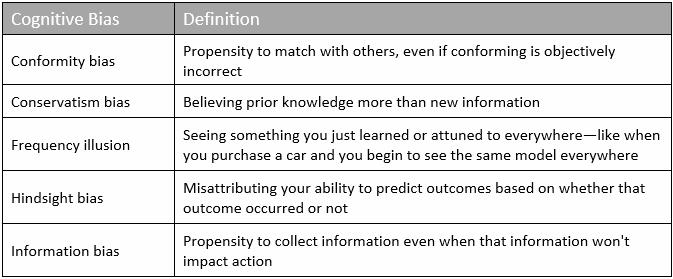A core way to add value to your organization if you are a marketing leader in the knowledge economy is to use data to make informed decisions. Data-derived insights guide marketers to make intelligent decisions, such as which markets to enter and what products to produce.
Basing decisions on data is so critical, that psychologists such as Daniel Kahneman, a Nobel Prize winner in economics, have dedicated significant research to understand how we make decisions. Kahneman's book, Thinking, Fast and Slow, is a great way to start unpacking the complexities inherent in any decision.
Cognitive Biases: The Enemies of Good Decisions
Data-driven decisions and a data-driven mindset are admirable qualities in a person—and advantageous qualities in an organization. They are a great start to good decision-making, but they are not enough.
Cognitive biases are the enemy of rational decisions. Those biases are the pesky thought traps that cause humans to do irrational things. Business Insider published an extensive list of cognitive biases in 2015 that illustrates 58 ways our biases can trip up our decision-making.
Here are some of the more prominent biases you should start addressing right away.
Anchoring bias: an overreliance on the first piece of information you're presented.
That first bit of data becomes the reference point against which all other options are compared. Clearly, if the data is way off the mark, its use as a reference point could be incredibly detrimental.
Combatting this bias is difficult: There always has to be a first piece of data presented. You could try breaking decision-making teams into smaller sub-teams and reordering the data to give each team a different anchor. When the teams integrate, they will have started from different points and therefore might end up in different places—yielding more robust decisions.
Bandwagon effect: a fundamental element of groupthink ("The probability of one person adopting a belief increases based on the number of people who hold that belief." —Lubin & Lebowitz, Business Insider, 2015)
We all know the dangers of groupthink, which is particularly challenging when an outsider joins an established group. Yet, that situation is exactly when the team could benefit most from an alternative perspective.
Keep beliefs private as much as possible when making important decisions. Hidden votes (secret ballots) are a common mechanism for doing that. The votes can be collected and presented back to the team. This approach also works in idea generation. Participants write down ideas or descriptions about the current environment, which are then collected and presented back holistically.
Choice-supportive bias: the tendency to feel positive about our choices even when those choices turn out to have shortcomings.
This bias can lead us to defend choices that are clearly not panning out or don't address all elements of a problem. To combat choice-supportive bias, we need to instill a culture that celebrates abandoning choices as much as we do making "successful" decisions. Here, the focus must be on the lessons that can be collected by abandoning the choice. The use of structured, parallel thinking exercises such as de Bono's Six Thinking Hats can give people the space they need to be self-critical.
Clustering illusion: when we see patterns in unrelated, random events.
This bias is especially important to address when developing a data-driven mindset. It's easy to create an Excel chart that seems to correlate totally unrelated variables. We need to use some common sense and skepticism when evaluating whether two phenomena are truly related.
Pressure-test, question, run an experiment... do anything you can to validate the interrelationship of two variables. It's enticing to find correlations, especially hidden ones.
It feels like the magic key to truly understanding the secret mechanisms driving your results. Embrace the possibilities with an optimist's heart and then confirm the relationship with a critic's mind.
Confirmation bias: focusing on information that supports a previously held belief and ignoring contrary information.
Probably the most understood bias, and for good reason. We've all been in an argument with people who fail to accept information that doesn't support their current worldview. It's been the bane of many businesses that failed to see the disruption happening right in front of them. Just ask Kodak, Blockbuster, or Nokia.
This is an insidious bias and very hard to mitigate. It might be helpful to create an environment where people aren't ridiculed for evolving their beliefs. Giving people a safe place to learn and grow when new information is presented might help reduce this tendency to entrench and consciously adopt a confirmation bias.
Observer-expectancy effect: tendency for our expectations to involuntarily impact how we interpret results.
You have to check your expectations when analyzing the results. Even with objective data, how you interpret that data to generate insights will definitely impact the decisions you make.
Pharmaceutical researchers use double-blind studies to combat this bias, and you can too. The simplest way? Separate the analyzer from the actor. Have an independent party—even internally—perform the analysis of the results. Without a vested interest or expectation for how the results should be interpreted, that analyst can render an impartial set of insights.
Recency bias: weighing the newest piece of information more heavily than previous evidence.
The opposite of conservatism bias (see table, below), this bias affects business decisions as much as it does fad dieting. Just because data is new doesn't make it more relevant than older information.
Formally weighing decision criteria as part of a decision matrix can simultaneously expose and counter this bias in real-time. By asking decision-makers to make objective tradeoffs between criteria, you force them to consider the relative merits of each criteria instead of just focusing on the most recent data point.
A few more biases:

(Combat biases with the right visualizations. Test your visualization knowledge by taking this short, interactive quiz.)
Mitigate If You Can't Eradicate
Cognitive biases help marketers manage the massive amounts of data we process, connect with others, and make decisions. So, even as they serve us in some cases, they can certainly be detrimental in others. We're not likely to eradicate all traces of cognitive biases any time soon. But by using the methods described in this article, as teams, we can definitely mitigate their negative impact and make better collective decisions.




